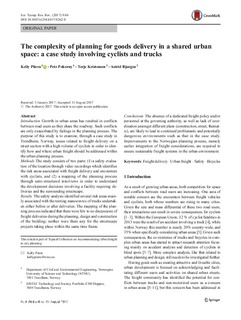| dc.contributor.author | Pitera, Kelly | |
| dc.contributor.author | Pokorny, Petr | |
| dc.contributor.author | Kristensen, Terje | |
| dc.contributor.author | Bjørgen, Astrid | |
| dc.date.accessioned | 2019-03-01T10:36:22Z | |
| dc.date.available | 2019-03-01T10:36:22Z | |
| dc.date.created | 2017-08-19T19:08:33Z | |
| dc.date.issued | 2017 | |
| dc.identifier.citation | European Transport Research Review. 2017, 9 (46), . | nb_NO |
| dc.identifier.issn | 1867-0717 | |
| dc.identifier.uri | http://hdl.handle.net/11250/2588224 | |
| dc.description.abstract | Introduction Growth in urban areas has resulted in conflicts between road users as they share the roadway. Such conflicts are only exacerbated by failings in the planning process. The purpose of this study is to examine, through a case study in Trondheim, Norway, issues related to freight delivery on a street section with a high volume of cyclists in order to identify how and where urban freight should be addressed within the urban planning process. Methods The study consists of two parts: (1) a safety evaluation of the location through video recordings which identifies the risk areas associated with freight delivery and encounters with cyclists, and (2) a mapping of the planning process through semi-structured interviews in order to understand the development decisions involving a facility requiring deliveries and the surrounding streetscape. Results The safety analysis identified several risk areas mainly associated with the turning manoeuvres of trucks undertaken either before or after deliveries. The mapping of the planning process indicated that there were few to no discussions of freight deliveries during the planning, design and construction of the building; neither were there any for the streetscape projects taking place within the same time frame. Conclusions The absence of a dedicated freight policy and/or personnel at the governing authority, as well as lack of coordination amongst different plans (construction, street, thematic), are likely to lead to continued problematic and potentially dangerous environments such as that in the case study. Improvements to the Norwegian planning process, namely earlier integration of freight considerations, are required to ensure sustainable freight systems in the urban environment. | nb_NO |
| dc.language.iso | eng | nb_NO |
| dc.rights | Navngivelse 4.0 Internasjonal | * |
| dc.rights.uri | http://creativecommons.org/licenses/by/4.0/deed.no | * |
| dc.title | The complexity of planning for goods delivery in a shared urban space: a case study involving cyclists and trucks | nb_NO |
| dc.type | Journal article | nb_NO |
| dc.type | Peer reviewed | nb_NO |
| dc.description.version | publishedVersion | nb_NO |
| dc.source.pagenumber | 10 | nb_NO |
| dc.source.volume | 9 | nb_NO |
| dc.source.journal | European Transport Research Review | nb_NO |
| dc.source.issue | 46 | nb_NO |
| dc.identifier.doi | https://doi.org/10.1007/s12544-017-0262-8 | |
| dc.identifier.cristin | 1487412 | |
| cristin.unitcode | 7401,60,60,0 | |
| cristin.unitname | Transportforskning | |
| cristin.ispublished | true | |
| cristin.fulltext | original | |
| cristin.qualitycode | 1 | |

